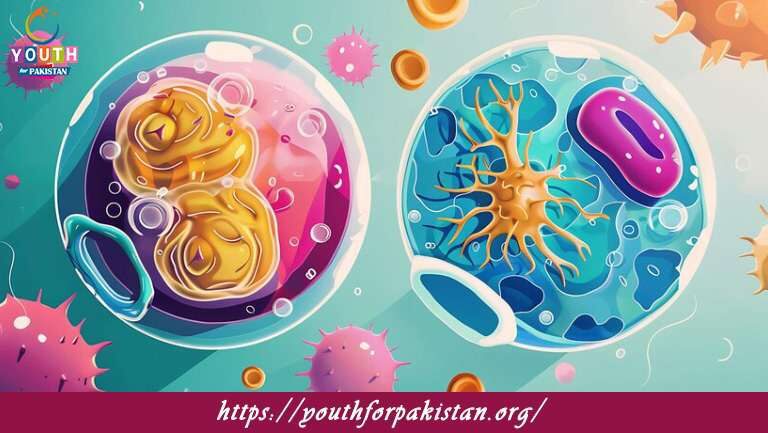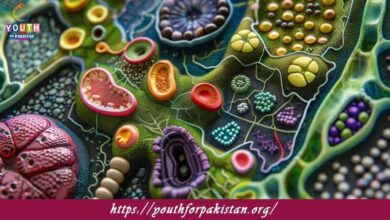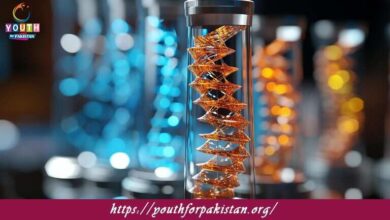11th Class Biology Chapter 6 MCQs with Answers

Prepare for exams with Kingdom Prokaryotae MCQs covering bacteria, archaea, and their roles in ecosystems. These questions delve into prokaryotic cell structure, reproduction, and significance, making Chapter 6 easier to grasp for 11th Class Biology students.
Which of the following characteristics is unique to Kingdom Prokaryotae?
a) Presence of a true nucleus
b) Membrane-bound organelles
c) Prokaryotic cells
d) Multicellularity
Kingdom Prokaryotae includes organisms that are primarily classified as .
a) Plants
b) Animals
c) Fungi
d) Bacteria and blue-green algae (cyanobacteri
a)
Which of the following is a distinguishing feature of prokaryotic cells?
a) Presence of a nucleus
b) Membrane-bound organelles
c) Cell wall
d) DNA replication
The cell wall of Kingdom Prokaryotae is composed of .
a) Cellulose
b) Chitin
c) Peptidoglycan
d) Lignin
Kingdom Prokaryotae includes both autotrophic and heterotrophic organisms. Which of the following is an example of an autotrophic prokaryote?
a) Escherichia coli (E. coli)
b) Streptococcus
c) Bacillus anthracis
d) Cyanobacteria (blue-green algae)
The genetic material in prokaryotic cells is found in the .
a) Nucleus
b) Nucleolus
c) Cytoplasm
d) Mitochondria
Which of the following is a common method of reproduction in prokaryotic cells?
a) Binary fission
b) Meiosis
c) Mitosis
d) Budding
Kingdom Prokaryotae includes organisms that are classified as .
a) Unicellular only
b) Multicellular only
c) Both unicellular and multicellular
d) None of the above
Which of the following is an example of a prokaryotic organism that can cause food poisoning?
a) Escherichia coli (E. coli)
b) Streptococcus
c) Bacillus anthracis
d) Cyanobacteria (blue-green algae)
The mode of nutrition in prokaryotes can be .
a) Autotrophic only
b) Heterotrophic only
c) Both autotrophic and heterotrophic
d) None of the above
Kingdom Prokaryotae includes the domain .
a) Archaea
b) Eukarya
c) Protista
d) Animalia
Which of the following is an example of a prokaryotic organism that plays a crucial role in nitrogen fixation?
a) Escherichia coli (E. coli)
b) Streptococcus
c) Rhizobium
d) Cyanobacteria (blue-green algae)
The cell membrane of prokaryotic cells is made up of .
a) Phospholipids and proteins
b) Cellulose and proteins
c) Peptidoglycan and lipids
d) Chitin and lipids
Which of the following is an example of a prokaryotic organism that is commonly used in the fermentation of milk to produce yogurt and cheese?
a) Escherichia coli (E. coli)
b) Streptococcus
c) Lactobacillus bulgaricus
d) Cyanobacteria (blue-green algae)
The process by which prokaryotes exchange genetic material through direct contact is called .
a) Conjugation
b) Transformation
c) Transduction
d) Binary fission
Which of the following is an example of a prokaryotic organism that is commonly used in the production of antibiotics?
a) Escherichia coli (E. coli)
b) Streptococcus
c) Bacillus subtilis
d) Cyanobacteria (blue-green algae)
Kingdom Prokaryotae includes organisms that are found in various habitats such as
.
a) Land and air only
b) Water only
c) Land, air, and water
d) None of the above
The structure that some prokaryotes possess for protection during unfavorable conditions is called .
a) Nucleus
b) Cell wall
c) Spore
d) Flagella
Which of the following is an example of a prokaryotic organism that is commonly used in the bioremediation of environmental pollutants?
a) Escherichia coli (E. coli)
b) Streptococcus
c) Pseudomonas aeruginosa
d) Cyanobacteria (blue-green algae)
The prokaryotic organisms that can survive extreme conditions such as high temperature and acidity are classified under the domain .
a) Archaea
b) Bacteria
c) Eukarya
d) Protista
Which of the following is an example of a prokaryotic organism that is commonly used in the production of vinegar?
a) Escherichia coli (E. coli)
b) Streptococcus
c) Acetobacter aceti
d) Cyanobacteria (blue-green algae)
The prokaryotic organisms that can survive in extreme environments such as hot springs and deep-sea vents are classified under the domain .
a) Archaea
b) Bacteria
c) Eukarya
d) Protista
Which of the following is an example of a prokaryotic organism that can carry out photosynthesis?
a) Escherichia coli (E. coli)
b) Streptococcus
c) Anabaena
d) Cyanobacteria (blue-green algae)
The prokaryotic organisms that are commonly found in the human intestines and play a role in digestion are classified under the domain .
a) Archaea
b) Bacteria
c) Eukarya
d) Protista
Which of the following is an example of a prokaryotic organism that can convert atmospheric nitrogen into a usable form for plants in the soil?
a) Escherichia coli (E. coli)
b) Streptococcus
c) Azotobacter
d) Cyanobacteria (blue-green algae)
The process by which prokaryotic cells take up free DNA molecules from their surroundings and incorporate them into their own genome is called .
a) Conjugation
b) Transformation
c) Transduction
d) Binary fission
Which of the following is an example of a prokaryotic organism that is commonly used in the production of bread and beer?
a) Escherichia coli (E. coli)
b) Streptococcus
c) Saccharomyces cerevisiae
d) Cyanobacteria (blue-green algae)
The mode of nutrition in prokaryotic organisms can be .
a) Autotrophic only
b) Heterotrophic only
c) Both autotrophic and heterotrophic
d) None of the above
Which of the following is an example of a prokaryotic organism that is commonly used in the production of antibiotics and yogurt?
a) Escherichia coli (E. coli)
b) Streptococcus
c) Lactobacillus bulgaricus
d) Cyanobacteria (blue-green algae)
The process by which prokaryotic cells transfer genetic material to other cells through virus-mediated mechanisms is called .
a) Conjugation
b) Transformation
c) Transduction
d) Binary fission
Which of the following is an example of a prokaryotic organism that is commonly used in the production of antibiotics and insulin?
a) Escherichia coli (E. coli)
b) Streptococcus
c) Saccharomyces cerevisiae
d) Escherichia coli (E. coli)
The prokaryotic organisms that can survive in extreme environments such as acidic lakes and hot springs are classified under the domain .
a) Archaea
b) Bacteria
c) Eukarya
d) Protista
Which of the following is an example of a prokaryotic organism that is commonly used in the production of antibiotics and biofuels?
a) Escherichia coli (E. coli)
b) Streptococcus
c) Saccharomyces cerevisiae
d) Escherichia coli (E. coli)
The prokaryotic organisms that are commonly found in soil and play a crucial role in nutrient recycling are classified under the domain .
a) Archaea
b) Bacteria
c) Eukarya
d) Protista
Which of the following is an example of a prokaryotic organism that is commonly used in the production of antibiotics and cheese?
a) Escherichia coli (E. coli)
b) Streptococcus
c) Lactobacillus bulgaricus
d) Escherichia coli (E. coli)
The process by which prokaryotic cells transfer genetic material to other cells through direct physical contact is called .
a) Conjugation
b) Transformation
c) Transduction
d) Binary fission
Which of the following is an example of a prokaryotic organism that is commonly used in the production of antibiotics and vinegar?
a) Escherichia coli (E. coli)
b) Streptococcus
c) Acetobacter aceti
d) Escherichia coli (E. coli)
The prokaryotic organisms that are commonly found in the human digestive system and play a role in digestion are classified under the domain .
a) Archaea
b) Bacteria
c) Eukarya
d) Protista
Which of the following is an example of a prokaryotic organism that is commonly used in the production of yogurt and biofuels?
a) Escherichia coli (E. coli)
b) Streptococcus
c) Saccharomyces cerevisiae
d) Lactobacillus bulgaricus
The process by which prokaryotic cells divide into two identical daughter cells is called
a) Conjugation
b) Transformation
c) Transduction
d) Binary fission
Which of the following is an example of a prokaryotic organism that is commonly used in the production of antibiotics and bread?
a) Escherichia coli (E. coli)
b) Streptococcus
c) Saccharomyces cerevisiae
d) Escherichia coli (E. coli)
The prokaryotic organisms that are commonly found in aquatic environments and play a crucial role in oxygen production are classified under the domain .
a) Archaea
b) Bacteria
c) Eukarya
d) Protista
Which of the following is an example of a prokaryotic organism that is commonly used in the production of antibiotics and biofuels?
a) Escherichia coli (E. coli)
b) Streptococcus
c) Saccharomyces cerevisiae
d) Escherichia coli (E. coli)
The prokaryotic organisms that are commonly found in the human mouth and play a role in dental plaque formation are classified under the domain .
a) Archaea
b) Bacteria
c) Eukarya
d) Protista
Which of the following is an example of a prokaryotic organism that is commonly used in the production of antibiotics and vinegar?
a) Escherichia coli (E. coli)
b) Streptococcus
c) Acetobacter aceti
d) Escherichia coli (E. coli)
The process by which prokaryotic cells take up DNA fragments from their surroundings and incorporate them into their own genome is called .
a) Conjugation
b) Transformation
c) Transduction
d) Binary fission
Which of the following is an example of a prokaryotic organism that is commonly used in the production of antibiotics and cheese?
a) Escherichia coli (E. coli)
b) Streptococcus
c) Lactobacillus bulgaricus
d) Escherichia coli (E. coli)
The prokaryotic organisms that can survive in extreme environments such as acidic lakes and hot springs are classified under the domain .
a) Archaea
b) Bacteria
c) Eukarya
d) Protista
Which of the following is an example of a prokaryotic organism that is commonly used in the production of antibiotics and biofuels?
a) Escherichia coli (E. coli)
b) Streptococcus
c) Saccharomyces cerevisiae
d) Escherichia coli (E. coli)
The prokaryotic organisms that are commonly found in soil and play a crucial role in nutrient recycling are classified under the domain .
a) Archaea
b) Bacteria
c) Eukarya
d) Protista
Which of the following is an example of a prokaryotic organism that is commonly used in the production of antibiotics and vinegar?
a) Escherichia coli (E. coli)
b) Streptococcus
c) Acetobacter aceti
d) Escherichia coli (E. coli)
The prokaryotic organisms that are commonly found in the human digestive system and play a role in digestion are classified under the domain .
a) Archaea
b) Bacteria
c) Eukarya
d) Protista
Which of the following is an example of a prokaryotic organism that is commonly used in the production of yogurt and biofuels?
a) Escherichia coli (E. coli)
b) Streptococcus
c) Saccharomyces cerevisiae
d) Lactobacillus bulgaricus
The process by which prokaryotic cells transfer genetic material to other cells through direct physical contact is called .
a) Conjugation
b) Transformation
c) Transduction
d) Binary fission
Which of the following is an example of a prokaryotic organism that is commonly used in the production of antibiotics and bread?
a) Escherichia coli (E. coli)
b) Streptococcus
c) Saccharomyces cerevisiae
d) Escherichia coli (E. coli)
The prokaryotic organisms that are commonly found in aquatic environments and play a crucial role in oxygen production are classified under the domain .
a) Archaea
b) Bacteria
c) Eukarya
d) Protista
Which of the following is an example of a prokaryotic organism that is commonly used in the production of antibiotics and biofuels?
a) Escherichia coli (E. coli)
b) Streptococcus
c) Saccharomyces cerevisiae
d) Escherichia coli (E. coli)
The prokaryotic organisms that are commonly found in the human mouth and play a role in dental plaque formation are classified under the domain .
a) Archaea
b) Bacteria
c) Eukarya
d) Protista
Which of the following is an example of a prokaryotic organism that is commonly used in the production of antibiotics and vinegar?
a) Escherichia coli (E. coli)
b) Streptococcus
c) Acetobacter aceti
d) Escherichia coli (E. coli)
The process by which prokaryotic cells take up DNA fragments from their surroundings and incorporate them into their own genome is called .
a) Conjugation
b) Transformation
c) Transduction
d) Binary fission
If you are interested to enhance your knowledge regarding Physics, Chemistry, Biology, and Computer please click on the link of each category, you will be redirected to dedicated website for each category.





